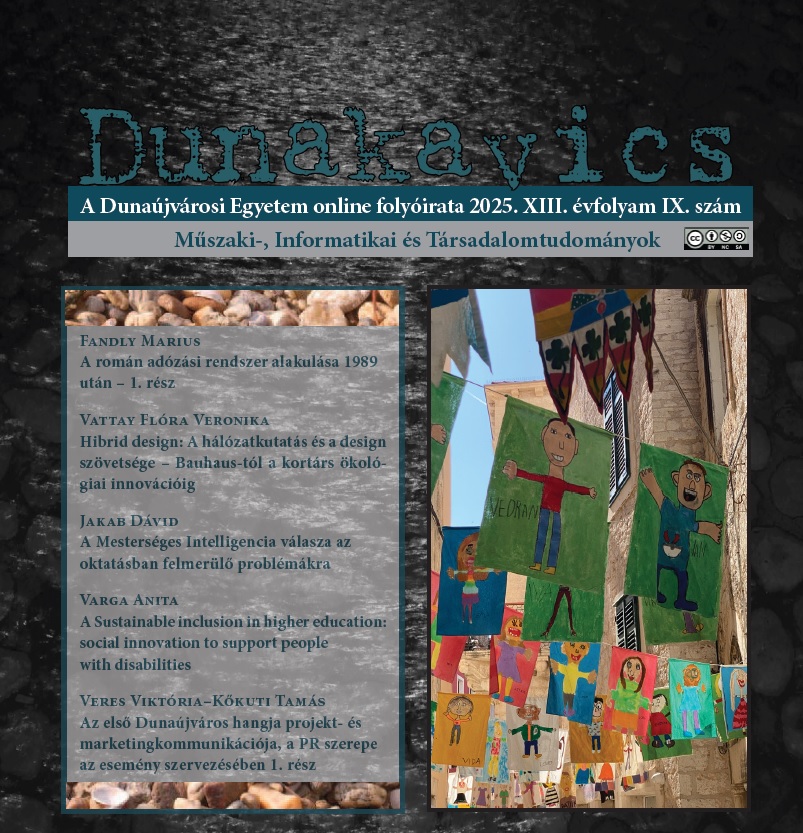Az első Dunaújváros hangja projekt- és marketingkommunikációja, a PR szerepe az esemény szervezésében 1. rész
Abstract
The success of an event or cultural project is greatly influenced by proper communication. Since there are many areas according to the meaning of communication science, in my opinion the most important elements of organization also come from here. The “Voice of Dunaújváros” was a singing competition, in the organization of which many of us participated, sometimes in smaller and larger roles. So, in study I examine the internal and external project communication and how successful the marketing strategy that accompanied the organization was. For study, set up the following hypothesis: "According to my assumption, the effectiveness of a new event, unknown in the given region, may be lower and less successful in terms of reaching the target audience than events that have already been held several times in the given region, possibly at the level of tradition. I assume that an event that is not yet known to the public will not attract as many visitors as those that are known to them.”
Factors outside the organizers may be more prominent in terms of whether they can attract the attention of the audience to an appropriate measure.
References
Balázs, Z. (2018). Társadalmi innováció a helyi közösségek fejlesztésében: Magyarországi esettanulmányok. Budapest: Gondolat Kiadó.
Bauer, M. W., Biwer, P., & Semmler, J. (2020). Social innovation and higher education: New approaches in European universities. Springer.
Benneworth, P., & Cunha, J. (2015). Universities' contributions to social innovation: Reflections in theory & practice. European Journal of Innovation Management, 18(4), 508–527. https://doi.org/10.1108/EJIM-10-2013-0099
Burgstahler, S. (2015). Universal design in higher education: From principles to practice. Harvard Education Press.
Chesbrough, H. W. (2006). Open innovation: The new imperative for creating and profiting from technology. Harvard Business School Press.
Elkington, J. (2004). Enter the triple bottom line. In A. Henriques & J. Richardson (Eds.), The triple bottom line: Does it all add up? (pp. 1–16). Earthscan Publications.
European Commission. (2020). Education and Training 2020: Inclusive education for all. European Union Publications.
European Commission. (2020). Social innovation as a pathway to a sustainable future. European Commission. Retrieved from https://ec.europa.eu/
European Commission. (2021). European Social Innovation Competition. Retrieved from https://ec.europa.eu/social/main.jsp?catId=1147
European Commission. (2021). European Solidarity Corps. Retrieved from https://europa.eu/youth/solidarity
European Solidarity Corps. (2021). European Solidarity Corps Guide 2021–2027. European Commission. Retrieved from https://europa.eu/youth/solidarity/mission_en
Etzkowitz, H., & Leydesdorff, L. (2000). The dynamics of innovation: From national systems and “Mode 2” to a Triple Helix of university–industry–government relations. Research Policy, 29(2), 109-123. DOI: https://doi.org/10.1016/S0048-7333(99)00055-4
Falus, I., & Németh, T. (2024). Oktatási esélyegyenlőség és társadalmi innováció: Kutatási eredmények és gyakorlati megközelítések. Debreceni Egyetemi Kiadó.
Falus, O., & Dósáné Pap, Gy. (2024). Az innováció jogi védelme: Példák az elektromobilitás köréből. In Falus, O., & Németh, I. P. (Eds.), Innovációs terek (pp. 135-143). Dunaújváros: DUE Press.
Gilardone, M., & Sen, A. K. (2010). The idea of justice. Social Choice and Welfare, 709-720. Harvard University Press.
Havas, A., & Nyíri, L. (2017). A társadalmi innovációk lehetőségei Magyarországon. Közgazdasági Szemle, 64(7-8), 726-750.
Kálmán, A., & Hübner, L. (2020). A digitális esélyegyenlőség kihívásai a magyar felsőoktatásban. Neveléstudomány, 8(3), 67–79.
Kálmán, A., & Kővári, B. (2018). Az egyetemes tervezés szerepe a magyar felsőoktatási intézményekben. Felsőoktatási Kutatóintézeti Szemle, 14(2), 45–58.
KIM (2024). A Kulturális és Innovációs Minisztérium Fogyatékosügyi koordinátori találkozó online 2024.06.11.
Kocziszky, G., Veresné Somosi, M., & Balaton, K. (2015). A társadalmi innováció vizsgálatának elméleti alapjai és módszertana. Miskolc: Miskolci Egyetem Gazdaságtudományi Kar.
Kozma, T. (2019). A társadalmi innováció értelmezései. Kultúra és Közösség, 10(1), 5-11.
Kozma, T., & Radácsi, L. (2013). Társadalmi innováció és felsőoktatás: A felelősségvállalás lehetőségei a magyar felsőoktatásban. Pécs: Pécsi Tudományegyetem Kiadó.
Kozma, T., & Rébay, M. (2021). Social inclusion in higher education: Challenges and opportunities. Hungarian Educational Research Journal, 11(2), 133-147.
Kuti, É. (2018). Társadalmi innováció és társadalmi vállalkozások. Új Mandátum Kiadó.
Mulgan, G. (2006). The process of social innovation. Innovations: Technology, Governance, Globalization, 1(2), 145-162.
Mulgan, G. (2012). The theoretical foundations of social innovation: The social origins of creativity and effectiveness. Palgrave Macmillan.
Mulgan, G. (2019). Social innovation: How societies find the power to change. Policy Press.
Nagy, J. T. (2021). The impact of social responsibility in higher education: A case study on Hungarian universities. Journal of Educational Policy and Development, 39(5), 168-181. https://doi.org/10.1080/02680939.2021.1810189
Nussbaum, M. (2011). Creating capabilities: The human development approach. Harvard University Press.
Pataki, G. (2012). A fenntarthatóság közgazdasági alapjai. Köz-Gazdaság, 7(2), 25-38.
Pérez, A., Sánchez, M., & Rodríguez, P. (2021). Social innovation and sustainable inclusion in higher education: The role of counseling and mentoring. Journal of Higher Education, 45(3), 204-220. https://doi.org/10.1016/j.jhe.2021.02.003
Porter, M. E., & Kramer, M. R. (2011). Creating shared value. Harvard Business Review, 89(1-2), 62-77.

This work is licensed under a Creative Commons Attribution-NonCommercial-ShareAlike 4.0 International License.




